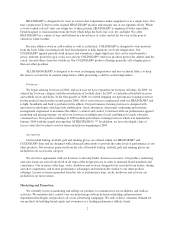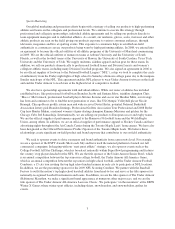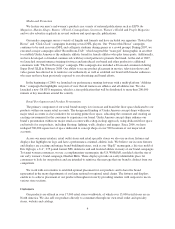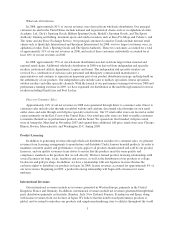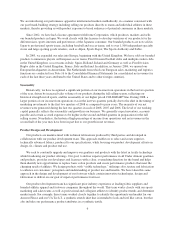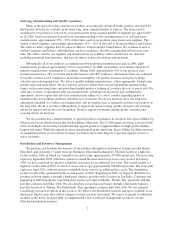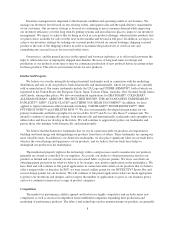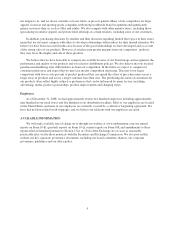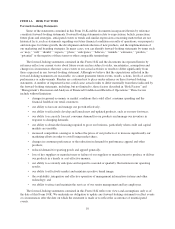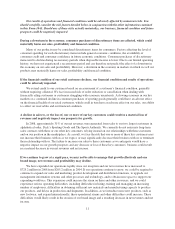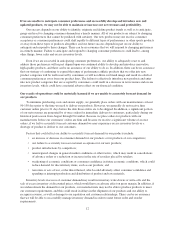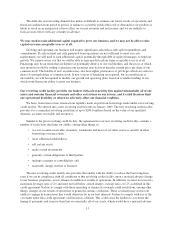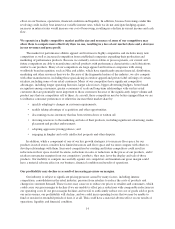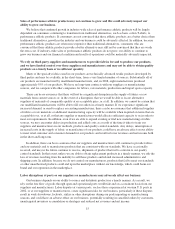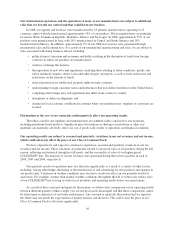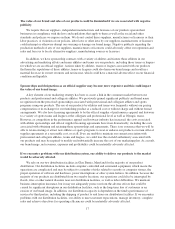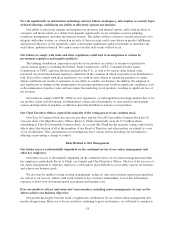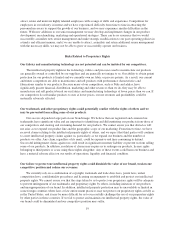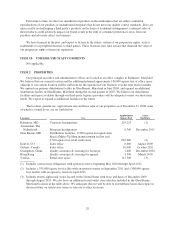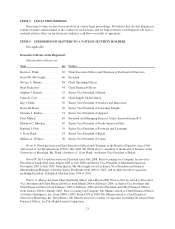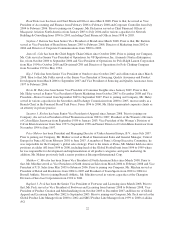Under Armour 2008 Annual Report Download - page 20
Download and view the complete annual report
Please find page 20 of the 2008 Under Armour annual report below. You can navigate through the pages in the report by either clicking on the pages listed below, or by using the keyword search tool below to find specific information within the annual report.If we are unable to anticipate consumer preferences and successfully develop and introduce new and
updated products, we may not be able to maintain or increase our net revenues and profitability.
Our success depends on our ability to identify, originate and define product trends as well as to anticipate,
gauge and react to changing consumer demands in a timely manner. All of our products are subject to changing
consumer preferences that cannot be predicted with certainty. Our new products may not receive consumer
acceptance as consumer preferences could shift rapidly to different types of performance or other sports products
or away from these types of products altogether, and our future success depends in part on our ability to
anticipate and respond to these changes. There can be no assurance that we will respond to changing preferences
in a timely manner. Failure to anticipate and respond to changing consumer preferences could lead to, among
other things, lower sales and excess inventory levels.
Even if we are successful in anticipating consumer preferences, our ability to adequately react to and
address those preferences will in part depend upon our continued ability to develop and introduce innovative,
high-quality products, and there can be no assurance of our ability to do so. In addition, there can be no assurance
that our strategy of continuing to expand the range of performance athletic products that we offer into new
product categories will be well received by consumers or will not dilute our brand image and result in a shift of
consumer preferences away from our product lines. The failure to effectively introduce new products and enter
into new product categories that are accepted by consumers could result in a decrease in net revenues and excess
inventory levels, which could have a material adverse effect on our financial condition.
Our results of operations could be materially harmed if we are unable to accurately forecast demand for
our products.
To minimize purchasing costs and ensure supply, we generally place orders with our manufacturers at least
90-150 days prior to the time we need to deliver our products. However, we generally do not receive firm
customer orders prior to 21 days before the date those orders are to be shipped. In addition, a significant portion
of our net revenues are generated by at-once orders for immediate delivery to customers, particularly during our
historical peak season from August through November. Because we place orders for products with our
manufacturers before our customers’ orders are firm and because we receive a significant volume of at-once
orders, if we fail to accurately forecast customer demand we may experience excess inventory levels or a
shortage of product to deliver to our customers.
Factors that could affect our ability to accurately forecast demand for our products include:
• an increase or decrease in consumer demand for our products or for products of our competitors;
• our failure to accurately forecast customer acceptance for our new products;
• product introductions by competitors;
• unanticipated changes in general market conditions or other factors, which may result in cancellations
of advance orders or a reduction or increase in the rate of reorders placed by retailers;
• weakening of economic conditions or consumer confidence in future economic conditions, which could
reduce demand for discretionary items, such as our products; and
• terrorism or acts of war, or the threat thereof, which could adversely affect consumer confidence and
spending or interrupt production and distribution of product and raw materials.
Inventory levels in excess of customer demand may result in inventory write-downs or write-offs and the
sale of excess inventory at discounted prices, which would have an adverse effect on gross margin. In addition, if
we underestimate the demand for our products, our manufacturers may not be able to produce products to meet
our customer requirements, and this could result in delays in the shipment of our products and our ability to
recognize revenue, as well as damage to our reputation and customer relationships. There can be no assurance
that we will be able to successfully manage inventory demand in order to meet future order and reorder
requirements.
12


